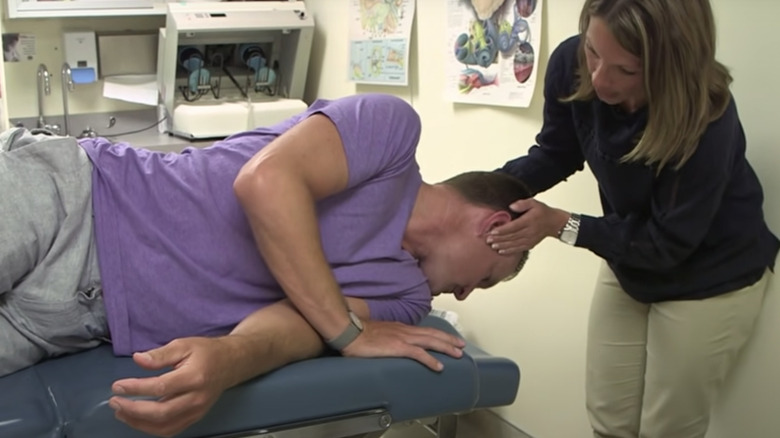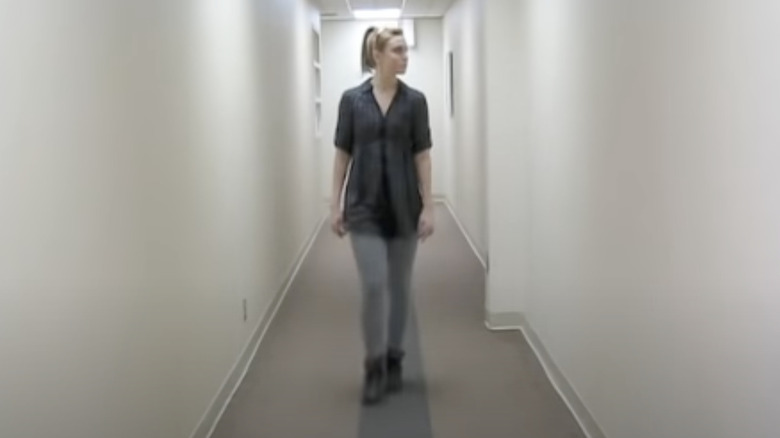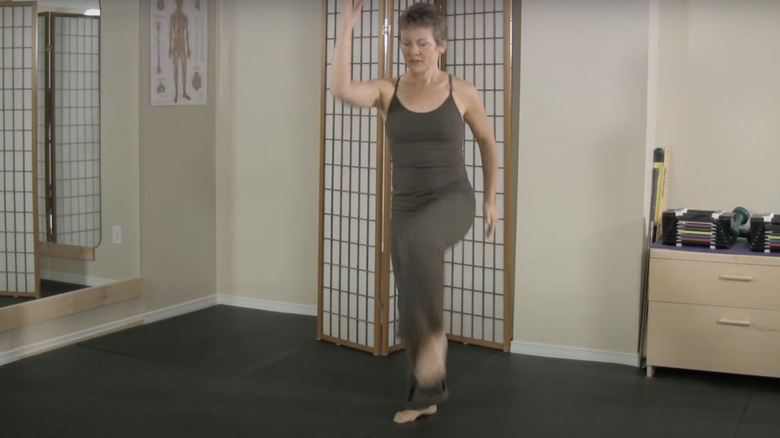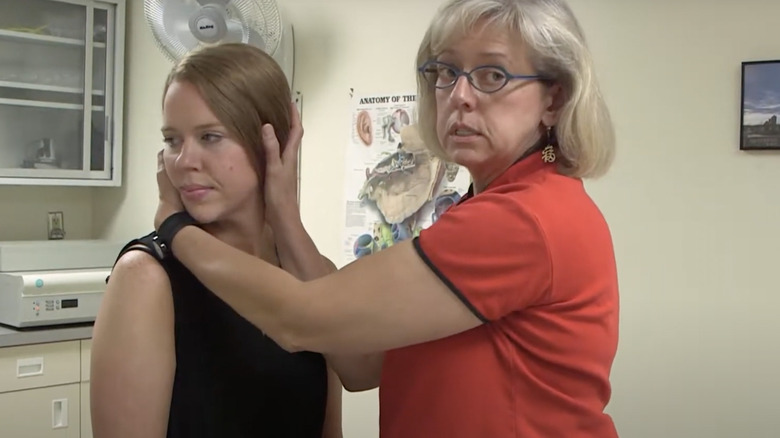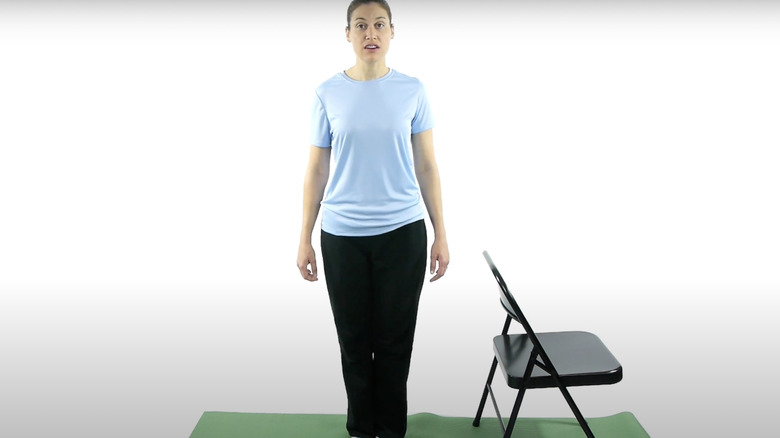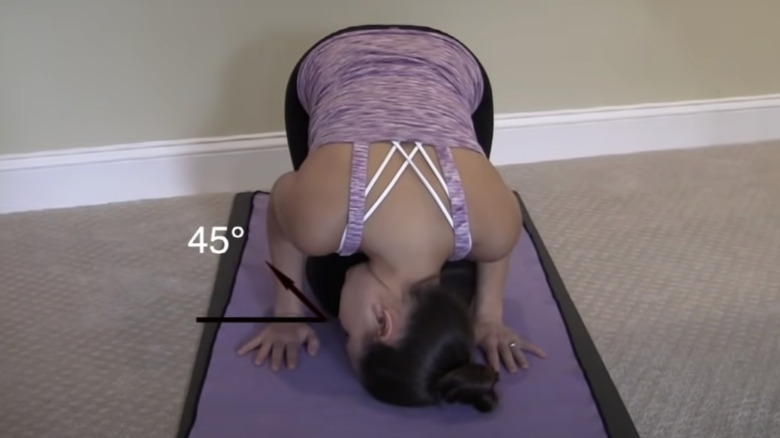The Best Exercises For Easing Vertigo Symptoms
Most people are familiar with the feeling of being a little dizzy from time to time, through standing up too fast or not eating for extended periods (per WebMD). But a persistent and more profound feeling of dizziness is a different matter.
This sensation, known as vertigo, can come in repeated waves, and in certain situations may last for periods of weeks or months, as the Cleveland Clinic explains. And anyone who's ever experienced vertigo will likely tell you that when it occurs, it can be difficult to operate normally, with vertigo potentially leading to a range of knock-on symptoms like vomiting and nausea, headaches, and tinnitus.
The good news is that while vertigo isn't a disease in itself, there are ways to reduce vertigo symptoms that can run in tandem with treatment for the condition causing it. One of the best ways to do that is with simple exercises, designed to ease dizziness and restore balance while not exacerbating your symptoms. The best part? Many of these exercises are easy to perform. Let's take a look at the best exercises to make your vertigo easier to handle.
How can exercises help vertigo?
To understand how exercises can help vertigo, we first have to take a look at what causes it in the first place.
Vertigo can usually be separated into two distinct types, with the symptoms caused either by an issue concerning the brain or the inner ear (or vestibular nerve), according to Medical News Today. Central vertigo, the brain-related type, is usually prompted by a brain injury or disease, like a brain tumor or a stroke, and is generally both severe and persistent, says WebMD. Peripheral vertigo, on the other hand, is far more common, and is caused when the inner ear and/or vestibular nerve (the part of the body that controls balance) is affected by a condition like Meniere's disease or benign paroxysmal positional vertigo (BPPV).
BPPV causes roughly 50% of all peripheral vertigo cases and occurs when calcium carbonate crystals in the inner ear canals shift, which results in the alteration to balance and dizziness that we know as vertigo (per research published in StatPearls). Exercises designed to help vertigo work to move these crystals to a more regular position, easing symptoms. It should be noted that while exercises are generally more useful for people with peripheral vertigo, for those with central vertigo, they may not be as helpful, and it's important to discuss treatment options with your doctor.
Epley maneuver
If your vertigo is caused by BPPV, the Epley maneuver is one of the best exercises to ease your symptoms. Designed by Dr. John Epley, this sequence of movements works to move the dislodged calcium carbonate crystals in the inner ear that cause vertigo back into the part of the ear they should typically reside in, as Johns Hopkins Medicine explains.
The Epley maneuver may be done on your own at home or with the assistance of a physiotherapist. The way that you do the maneuver will depend on which ear is affected. If you're experiencing issues with your left ear, you'll need to begin the maneuver by sitting upright on a bed, with your pillow behind you and your legs outstretched in front of you. Gently turn your head to your left-hand side until it's at a 45-degree angle. From here, you'll need to lean back quickly and lie down on your back, so that your head and shoulders are on the pillow, your head at the same angle. Hold the position for 30 seconds, and then gently rotate your head so that it's at a 45-degree angle to the right-hand side. Hold for 30 seconds again. Finally, rotate your body to the right, with your head following too. You should turn both 90 degrees, meaning that your body's on its side and your head's facing the bed. Hold for 30 seconds, and then sit up. For the right ear, simply reverse the movements.
Brandt-Daroff exercises
In the realm of vertigo exercises, the Brandt-Daroff exercises stand tall as one of the most well-known. Particularly useful for people who have vertigo as a result of BBPV, the Brandt-Daroff exercises can be done in the comfort of your own home, and are especially good for people who have back trouble (per Healthline). While they can be performed without the help of a doctor, it's always a good idea to let your healthcare provider know you're trying the exercises.
Begin by sitting on the side of your bed, with your feet planted flat on the ground in front of you and your hands on your lap. Turn your head to one side at a 45-degree angle, and then allow your body to lie down in the other direction, resting on your side, with your legs staying bent and coming up onto the bed. Hold the position for 30 seconds, keep your gaze looking upward, and then return to your first sitting position. Hold the sitting position for 30 seconds, and then repeat the head-turning, lying-down movement on the other side, again holding when lying down for half a minute. Return to sitting. Repeat on each side for a total of five times, and then when finished, rest. The best results come from doing the Brandt-Daroff exercises daily, for a period of up to two weeks.
Walking while turning your head
Don't underestimate walking when it comes to treating vertigo. While we typically take walking for granted, it takes constant balance to do it safely and effectively, as MyHealth Alberta says. And by bringing attention to walking and practicing simple head movements throughout, it's possible to improve balance and reduce vertigo symptoms.
Put this into practice by performing an exercise that may be harder than it looks: walking while turning your head. Position yourself in an area with ample distance in front of you, roughly 15 meters or so if possible, although you can double back on yourself. You may also want to walk in an area that has some kind of support (like a handrail or wall) if you're concerned about losing balance. Walk forward, and with every other step you take, turn your head to the right, and then to the left. Try and do this for a total of 15 meters. Then, walk the same distance, moving your head down and up every other step. Finally, walk 15 meters while leaning your head from side to side, so that each ear is coming down to each shoulder. Try and do the full set of exercises twice daily, with someone assisting you if necessary. Also, bear in mind that you may find it hard at first, but over time, your balance should improve.
Marching in place
Vertigo can seriously affect your balance, and for people who experience it consistently, it may make activities as simple as walking or standing up difficult. One of the best ways to combat this is by practicing exercises that can help you build up your balance in a standing position, which may then allow you to perform further movements with greater ease (per WebMD).
Marching in place is a simple exercise that can help you do this. Begin by standing up straight, with your hands by either side of your body. It may be helpful or comforting to stand near a stable object, like a wall or a chair, to support you should you lose your balance. Then, perform a marching motion while standing still — first raising one knee, then the other — for a total of 20 steps on each side. Ensure that you're lifting your knees as far as you can go while remaining steady. Rest after 20 steps, and then repeat the exercise later in the day. Once you're comfortable with the exercise, you can try and raise your step count to 30 steps on each side.
Semont maneuver
The Semont maneuver, also known as the liberatory maneuver, is a common exercise used by physical therapists and doctors to treat BPPV (per Healthline). The Semont maneuver can be used to move the crystals that cause BPPV and subsequent vertigo back into place. However, it should be pointed out that as this exercise involves rapid movements and may result in dizziness afterward, it's advisable to do it with a healthcare professional, and only perform it solo if they say it's safe to do so.
The Semont maneuver varies depending on the ear that's affected. You'll start by sitting on the edge of a bench or table, with your legs over the edge. Then, turn your head to one side — the opposite side to the affected ear — until it's at a 45-degree angle. Then, lie down quickly on the affected side with your gaze facing upward, and hold the position for a while. If you feel dizzy at this point, you should resist moving until it's fully passed. Return to your sitting position, and then, keeping your head in the same position, lie down on the other side so that your head is facing the table. Again, hold the position until any dizziness abates, and then return to sitting. Do not try and move until all dizziness has fully passed, and ensure that you don't drive for a few hours after the maneuver.
Romberg exercise
Vertigo can have a profound effect on the things we take for granted in life. And one of them, simply standing still, can be seriously impacted by symptoms of vertigo. It can even lead to an increased risk of falling or injury (per Lawrence Otolaryngology Associates). One of the best ways to combat this is by simply practicing standing up.
The Romberg exercise (or Romberg stance) is a tried-and-tested way to manage vertigo and balance (via Hartford Healthcare). Start by finding a sturdy chair, and placing it in front of you, with your back to a wall behind you. Both of these things act as support mechanisms, to stabilize you if you lose balance. You can also ask someone to move the chair into position for you if it's too challenging to do so. Then, stand up straight, with your feet placed together, your arms placed by your side, and your gaze forward. Hold the Romberg stance for up to 30 seconds, trying to maintain balance throughout, and then rest. Repeat twice daily, eventually working up to doing it with your eyes closed.
Foster maneuver
Exercises that treat vertigo often seek to restore balance in the inner ear and vestibular systems, and the Foster maneuver is another that does just this. Designed by Dr. Carol Foster, this maneuver varies from similar BPPV maneuvers like the Epley and Semont exercises by having the patient perform it on their hands and knees, which could be beneficial for people who have trouble lying down (per Dizziness and Balance).
Begin this exercise (which is also called the Half-Somersault maneuver) by moving onto your hands and knees, as WebMD explains. Move your head up so you're looking at the ceiling, and then after a few seconds, touch your forehead to the floor in front of you, tucking your chin in. Hold the position here for 30 seconds, and then turn your head to the side where you're experiencing vertigo, to a 45-degree angle. Then, bring your head up fairly quickly, with your arms coming up but staying connected to the ground. You should end up remaining on all fours, but with your head level with your back and at the same angle. Hold for 30 seconds, and then finally, raise your head, keeping it at the same angle, so that you're sitting back on your knees. Wait for any dizziness to stop, and then stand up.
Turning in place
Sometimes, the simplest exercises are the best. Turning in place may seem like a small move, but the act of doing so can have a big effect on any inner ear imbalances or other causes of vertigo, helping to relieve symptoms.
To do this exercise, it's best to place a sturdy object nearby, in case you become unsteady or dizzy midway through, as WebMD states. Begin by standing upright, with your back straight and your arms placed by either side of your body. Then, begin turning your body to the side where you're experiencing dizziness until you're facing the other direction. Pause once you've completed a half-turn, and stand still for 15 seconds or so. From here, you'll want to turn back the way you came, at the same speed, until you're facing the original direction. Stand still for roughly 15 seconds again, before repeating the exercise. Try to aim to turn in place five times in total, pausing and stopping if you feel any extreme dizziness, and remember to take things slowly.
Gaze stabilization exercise
The eyes are heavily involved with our balance system, with the brain and eyes working in tandem to maintain focus and stability when while a person is moving (per the Meniére's Society). When you experience vertigo, however, your eyesight can become imbalanced, contributing to a greater overall feeling of dizziness. Vertigo can also occur as a result of your eyes becoming unfocused, misaligned, or strained, a condition known as visual vertigo (per Vision Specialists of Michigan). Working on your eyesight to restabilize your gaze may help to reduce symptoms.
A simple gaze stabilization exercise can be performed using just a piece of card, says NHS Torbay and South Devon. Grab a small piece of card with some writing on it, and hold it in front of your face so you're still able to read it. Keeping your gaze fixed on the writing, move your head first to one side, then the other, ensuring that your movements are controlled. Try and move your head so it goes just far enough that the writing moves out of focus each time. Keep going for a few minutes. You may feel a little unbalanced or dizzy doing this, but that's completely normal — just make sure you're stopping or slowing down if it feels seriously uncomfortable. Once you've mastered this, you can test yourself further by doing it with different backgrounds behind the card, like curtains or patterned wallpaper.
Walk and stop
When it comes to vertigo exercises, testing your balance is an important factor to help improve it and reduce symptoms (per MyHealth Alberta). And one of the movements we're most used to in life — walking and then stopping — is a great way to do just that.
To do this exercise, set yourself up in an area that has a good amount of distance, like a long hallway or a garden. If your vertigo is severe, or you have concerns about balance, it's advisable to do this in a place where you have easy access to something stable to grip onto in case you fall. Walk forward, taking five steps, before stopping yourself suddenly, trying to maintain your balance as you do so. Pause once you've stopped until any dizziness you're experiencing wears off (usually around 10 seconds or so), and then walk another five steps, stopping abruptly again. Continue doing this until you've walked a distance of about 15 meters before resting. Once you can do the exercise capably, try and build up your distance even more, aiming for 30 meters.
How to work out with vertigo
There are many specific exercises out there that can assist in reducing vertigo symptoms, but what about exercising more generally? Working out when you have vertigo can be a real challenge, and it can result in a reluctance or a fear of performing physical activity, says the Dizzy & Vertigo Institute of Los Angeles.
It's important to try and maintain exercise wherever possible, though, to avoid any subsequent health challenges caused by a loss of physical fitness. The best thing to do is to stay well aware of your comfort level around exercise with vertigo, and not to overexert yourself. Begin with low-intensity workouts like walking, tai chi, or light resistance training, to ensure that you're remaining active while not destabilizing yourself too much. Try and keep your head as steady as possible during any exercise you're doing, and avoid jerking it around too much. It can also be helpful to work out while keeping your gaze on a fixed spot. Once you're comfortable with the exercise, you can then try to ramp up the intensity.
Above all, make sure that with any exercise you're doing, you're also sticking to any prescribed treatment and/or physical therapy for your vertigo.
How else can I treat my vertigo?
While exercises are an important tool in treating vertigo, they're far from the only way to do so. Vertigo is a symptom of an underlying condition, and treating whatever's causing your dizziness is vital, as NHS Inform states.
Vertigo that's prompted by labyrinthitis or vestibular neuronitis is due to the infection that's causing the conditions, and treatment may be delivered via antibiotics or simple bed rest. It's important to try and avoid triggers for vertigo when it's prompted by these conditions, like drinking alcohol or fatigue. Vertigo caused by Meniére's disease can be treated with medication, or by making lifestyle changes like reducing the amount of salt in your diet.
While exercises can be especially useful for treating BPPV, it's important to alert your healthcare provider if they don't reduce symptoms, or aren't working after a specific length of time. In certain cases, especially when vertigo is persistent and lasts for months on end, you may be advised to have surgery to treat the cause. It's also important to remember that when you have long-term vertigo, you may have to make certain lifestyle changes to accommodate for your condition, like reducing the amount of driving you do or telling your employer about your illness.



